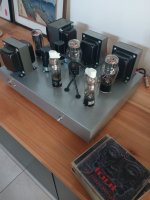Or if you are using a hum pot then the middle terminal is connected to the cathode resistor and the left/right terminals are connected to the filament pons of the socket. Otherwise the cathode is shorted to ground and you will see exactly what you have now, almost no cathode voltage and way to much dissipation in the output tube….
I don't understand. I have three wires going out to the 2A3, two for 2.5V (1.3V each) and one for the center tap. Do the two 2.5V wires go to the pot and the center tap?
------ 1.3V -|
------ center tap -| 2.5V
------1.3V -|
i have a pic of the conection in the post #93
------ 1.3V -|
------ center tap -| 2.5V
------1.3V -|
i have a pic of the conection in the post #93
I'm using a transformer made in my country by a reputable technician, 2.5v with a midpoint, maybe if I don't connect the midpoint on the grown bus?
It measures 2.5v between the 2 outputs of the transformer, and on the pot
What do you mean by this statement exactly?
Does the 2.5V transformer winding you're using for the heater have a center tap? And if so is that center tap connected to anything at all?
The center tap of the 2.5 V transformer should be attached to the cathode resistor and cathode bypass cap, absolutely NOT to ground!
I don't understand this, if I already have 2 cables with 2.5v that go to the potThe center tap of the 2.5 V transformer should be attached to the cathode resistor and cathode bypass cap, absolutely NOT to ground!
mctavish is assuming you don't have a hum pot. You should do as Robert H. Gribnau suggests. With the current arrangement, you are roasting your 2A3s.
im a idiotWith the current arrangement, you are roasting your 2A3s.
Can you make me a diagram?
He knows I have a potSince the cathode resistor and cathode bypass capacitor are connected to the wiper of the anti-hum pot, the obvious thing to do is to disconnect the center tap of the 2.5 V transformer from ground and leave it unconnected
The two outer leads of the 2.5 V transformer go to the heater of the 2A3. The anti-hum pot is connected between the two heater pins. The cathode resistor and cathode capacitor are connected between the wiper of the anti-hum pot and ground. Looking at the first picture in your post # 93 you already connected it this way.
But (again): Disconnect the CT of the 2.5 V transformer from ground. Do not connect the CT to anything else.
By connecting the CT of the 2.5 V transformer to ground, the heater of the 2A3 is practically connected to ground. In this situation the cathode resistor does not do anything (it does not pass any current since both ends of the cathode resistor are practically connected to ground), so there is no bias (the voltage difference between the control grid and the cathode is practically zero V). This makes that the 2A3 will pass way too much current.
But (again): Disconnect the CT of the 2.5 V transformer from ground. Do not connect the CT to anything else.
By connecting the CT of the 2.5 V transformer to ground, the heater of the 2A3 is practically connected to ground. In this situation the cathode resistor does not do anything (it does not pass any current since both ends of the cathode resistor are practically connected to ground), so there is no bias (the voltage difference between the control grid and the cathode is practically zero V). This makes that the 2A3 will pass way too much current.
The good news is that the high current caused the plate voltage to only be 154 V. Plate dissipation (15 Watt maximum for the 2A3) is cathode to plate voltage times current, so 154 V x the unknown current.
Power tubes are generally sturdy things. But you have to wait and see, so fingers crossed.
Power tubes are generally sturdy things. But you have to wait and see, so fingers crossed.
Well, the amp works; the voltages appeared correctly. Thank you very much, everyone. I was a bit of an idiot connecting the midpoint to ground, but like with the 6c6 and previous amps, I did it and had no problem. I trusted myself. I turned on the amp and some hum could be heard, but I lowered it by moving the hum pot. It worked great. Now I need some good, sensitive speakers to show me its full potential. For now, I'll use it with some JBL 130s at 84 dB.
Thanks again everyone, I still have a lot to learn.
Thanks again everyone, I still have a lot to learn.
Attachments
- Home
- Amplifiers
- Tubes / Valves
- Radiotron 2A3 values?
